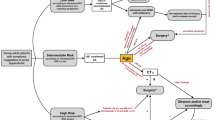Summary
From three different surgical departments 78 patients with purulent peritonitis are analyzed according to cause, origin, and extent of peritonitis. Operative therapy is presented. As additional antibacterial therapy the new chemotherapeutic agent, Taurolin, with antiendotoxin-effect is used. The postoperative course (temperature exceeding 38 °C, secondary wound healing, day of discharge, and serious complications) is correlated with pre- and intraoperative parameters; for instance, 1. postoperative fever occurs in one half of the patients, more frequently following perforation of stomach and duodenum; 2. every second patient shows secondary wound healing, this happens even more often in peritonitis arising from biliary disease or appendicitis; 3. in 29.5 % of the patients serious complications arise, especially in patients with peritonitis originating in stomach, small intestine or large bowel; 4. overall mortality of 11.5 % is surpassed in patients with peritonitis originating from small intestine or large bowel. The so-called peritonitis-index (calculated on the basis of pre- and intraoperative factors) shows a significant difference between survivors and patients dying during the postoperative course. In 80 % of the 78 patients with purulent peritonitis taurolin was effective as a substitute for the usual antibiotics.
Zusammenfassung
78 Kranke mit waschungsbedürftiger Bauchfellentzündung aus drei chirurgischen Kliniken werden nach Ursprungsort, Art und Ausmaß der Peritonitis analysiert. Die operative Therapie wird dargestellt. Bei diesen 78 Kranken wird als zusätzliche Behandlung das neue Chemotherapeuticum und Antiendotoxin Taurolin anstelle eines Antibioticum angewandt. Über den postoperativen Verlauf wird detailliert berichtet (Temperaturen über 38 °C, Sekundärheilung, Entlassungszeitpunkt und ernstere Komplikationen). Eigenschaften des postoperativen Verlaufs lassen sich mit prä- und intraoperativen Befunden korrelieren: 1. postoperatives Fieber über 38 °C tritt bei der Hälfte der Patienten auf, überdurchschnittlich häufig nach Perforation von Magen und Zwölffingerdarm; 2. jeder zweite Patient heilt sekundär, vermehrt häufig nach gallenwegsbedingter und appendicitischer Peritonitis; 3. ernstere Komplikationen ereignen sich bei 29,5 % der Patienten, besonders nach Peritonitis ausgehend von Magen, Dünn- oder Dickdarm; 4. die Gesamtletalität von 11,5 % wird bei Dünn- oder Dickdarmbedingter Peritonitis deutlich überschritten. Der Peritonitisindex gebildet aus prä- und intraoperativen Faktoren kann signifikant zwischen den später Verstorbenen und Überlebenden unterscheiden. Bei 80 % dieser 78 Kranken mit schwerer Peritonitis war Taurolin ohne zusätzliche Gabe eines Antibiotikum erfolgreich.
Similar content being viewed by others
Literatur
Altemeier, W. A.: The changing phenomenon of surgical infections. Abstract: Congress Societé Internationale de Chirurgie, Kyoto, S. 152–153, 1977
Artz, C. P., Barnett, W. O., Grogan, J. B.: Further studies concerning the pathogenesis and treatment of peritonitis. Ann. Surg.155, 756–767 (1962)
Browne, M. K., Leslie, G. B., Pfirrmann, R. W.: Taurolin, a new chemotherapeutic agent. J. Appl. Bacteriol.4, 363–368 (1976)
Browne, M. K., Leslie, G. P., Pfirrmann, R. W., Brodhage, M.: The in vitro and in vivo activity of taurolin against anaerobic pathogenic organisms. Surg. Gynecol. Obstet.145, 842–846 (1977)
Browne, M. K., Mac Kenzie, M., Doyle, P. J.: A controlled trial of taurolin in established bacterial peritonitis. Surg. Gynecol. Obstet.146, 721–724 (1978)
Cohn, I.: Peritonitis. Drug Therapy3, 19–28 (1978)
Eckert, P., Eichfuß, H. P., Eichen, R., Schassan, M. M.: Intraperitonale Antibioticatherapie bei diffuser Peritonitis: experimentelle und klinische Studie. Kongreßbericht der Österreichischen Gesellschaft für Chirurgie, Graz 1977. Hrsg.: Kraft-Kinz, J., Kronberger, L.
Eckert, P., Eichfuss, H. P.: Peritonitis. Stuttgart: Thieme 1978
Hahn, H.: Bakterielle Ursachen der Peritonitis, im Peritonitis. Hrsg.: Haring, R., S. 51–54. Bad Oeynhausen: TM-Vlg. 1979
Kirschner, M.: Die Behandlung der akuten eitrigen freien Bauchfellentzündung. Kongreßbericht der Deutschen Gesellschaft für Chirurgie, S. 253–311, 1926
Leigh, D. A.: Wound infections due to bacteroides fragilis following intestinal surgery. Br. J. Surg.62, 375–378 (1975)
Linder, M. M., Götz, J., Ott, W., Bühler, H. V., Wicki, O., Marti, M. C., Moser, G.: Therapie der eitrigen Peritonitis mit dem neuen Chemotherapeutikum und Antiendotoxin Taurolin in Peritonitis. Hrsg.: Haring, R., S. 79–82. Bad Oeynhausen: TM-Vlg. 1979
Linder, M. M., Götz, J., Ott, W., Wesch, G.: Ein Peritonitis-Index bei der von den Gallenwegen ausgehenden Bauchfellentzündung: Korrelation mit dem postoperativen Verlauf. Langenbecks Arch. Chit.350, 103–112 (1979)
Linder, M. M., Ott, W., Wesch, G.: Die antibakterielle Behandlung der eitrigen Peritonitis: prospektiver randomisierter Vergleich von Antibiotica mit dem neuen Chemotherapeuticum und Antiendotoxin Taurolin. Langenbecks Arch. Chir. [Suppl] Chir. Forum1980, 67–71 (1980)
Moser, G., Marti, M. C.: A propos de 40 cas de péritonites traiteés sans antibiotiques: application intraperitoneale et intraveineuse de Tauroflex. Schweiz. Rundsch. Med. (Praxis)67, 425–428 (1978)
Nelson, J. L., Kuzman, J. M., Cohn, J.: Intraperitoneal lavage and kanamycin for the contaminated abdomen. Surg. Clin. North Am.55, 1391–1395 (1975)
Smith, E. B.: A rationale for intraperitoneally administered antibiotic therapy. Surg. Gynecol. Obstet.143, 561–564 (1976)
Stone, H.: Pers. Mitteilung, Frankfurt 1980
Wesch, G., Linder, M. M., Ott, W., Götz, J.: rognostische Faktoren der Peritonitis bei akuter Appendicitis. Fortschr. Med.99, 134–139 (1981)
Wicki, O., Pfirrmann, R. W.: Taurolin bei Peritonitis. In: Lokalbehandlung chirurgischer Infektionen. Hrsg.: Burri, C., Miter, A., S. 42. Bern, Stuttgart, Wien: Verlag Hans Huber 1979
Author information
Authors and Affiliations
Rights and permissions
About this article
Cite this article
Linder, M.M., Ott, W., Wesch, G. et al. Die Behandlung der eitrigen Bauchfellentzündung. Langenbecks Arch Chiv 353, 241–250 (1981). https://doi.org/10.1007/BF01266009
Received:
Issue Date:
DOI: https://doi.org/10.1007/BF01266009




